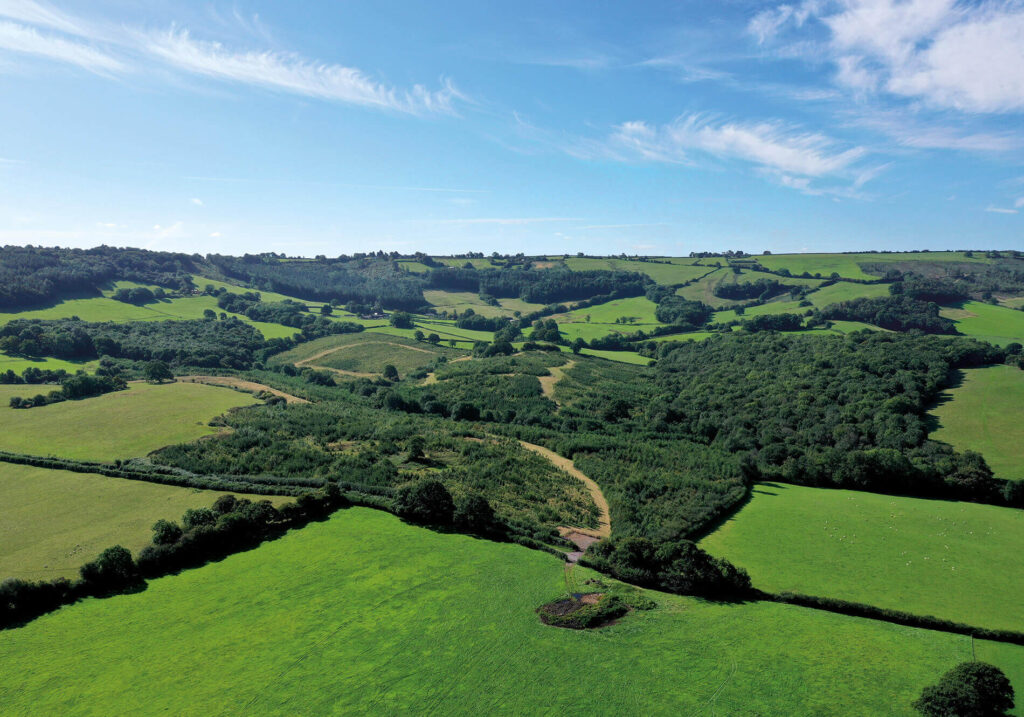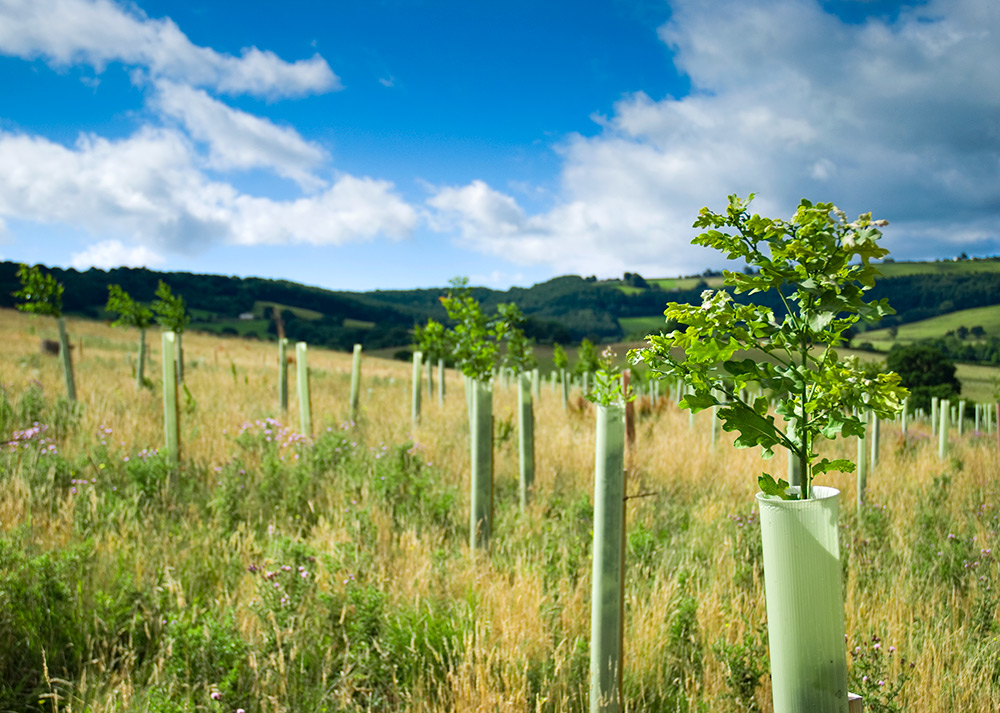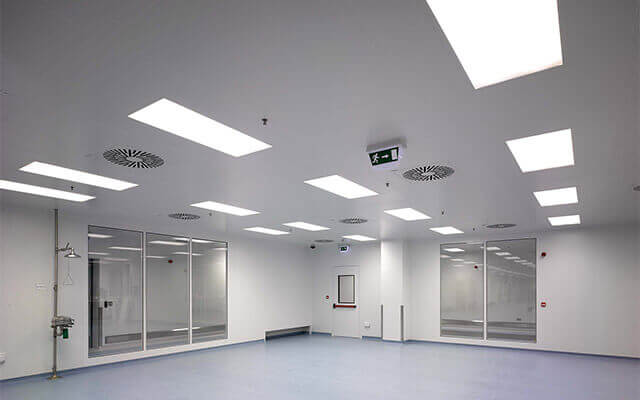
Carbon Offsetting with Solite
The FW Thorpe Commitment
179,412
trees planted since 2009
Solite is part of the FW Thorpe Plc group of companies. FW Thorpe is fully committed to minimising the environmental impact of both its manufacturing processes and its products. However, even with the most responsible approach, some carbon dioxide (CO₂) will be released into the atmosphere as an indirect result of factory and selling activities and customers’ use of luminaires. In 2009 FW Thorpe designed an ambitious carbon-offsetting scheme to help compensate for these emissions.
The final tree has been planted at our carbon offsetting project in Wales, having planted a total of 179,412 trees since 2009, which will offset 44,385 tonnes of CO₂e over a period of 100 years, but this doesn’t mean we are done, as part of our continual commitment to the environment, we will soon be planting again on our new plot of land in Herefordshire, on the Welsh border.
What is Carbon Offsetting?
Minimising the environmental impact
FW Thorpe has worked hard to develop and implement a truly effective environmental management system and is proud to have achieved ISO14001:2015 certification. ISO 14001:2015 confirms that a management system meets the highest of international environmental standards.
In June 2019, parliament passed legislation requiring the government to reduce the UK’s net emissions of greenhouse gases by 100%, relative to 1990 levels, by 2050. Doing so would make the UK a ‘net zero’ emitter. Net zero refers to achieving a balance between the amount of greenhouse gas emissions produced and the amount removed from the atmosphere. CO₂ is seen as the largest contributor to climate change.
Solite, therefore aims to minimise energy consumption associated with its products, both directly during manufacturing and selling activities and indirectly via the users of its products (lighting accounts for 20% of the energy consumed globally). By continuing to design and manufacture luminaires that are as optically and energy efficient as possible, fewer luminaires are required on a lighting scheme and power consumption is reduced. Solite luminaires use energy efficient control gear and LED circuits. Electronic control systems can further reduce energy consumption by reducing output in response to the presence of natural daylight or by turning lighting off due to a lack of presence. Use of the Solite SmartScan wireless lighting management system can show significant energy savings of up to 70% compared to a similar uncontrolled lighting system.

What is a carbon footprint?
The carbon footprint is a measure of the amount of CO₂ and other greenhouse gases emitted by a human activity or accumulated over the full life cycle of a product or service. A manufacturing process or lighting installation will always have a carbon footprint. Solite calculated that each luminaire indirectly creates an average of 5.615 kilograms of CO₂ during its production and marketing to the point where it leaves the factory and is delivered on a company vehicle.
No matter how efficient the luminaire is and how effective the control system is, a lighting installation still requires some electricity to operate. A 250 W luminaire, for example, may create up to 8.95 tonnes of CO₂e due to the electricity used during its 20-year life. That is around 2,500 times the amount generated during its production. A 116 W garage forecourt floodlight operated on a 24-hour cycle will consume 1,120 kWh of electricity and indirectly produce 200 kg of CO₂e per annum.

The FW Thorpe Carbon Offsetting Project
FW Thorpe has chosen to plant trees. Why trees? Trees and other plants absorb CO₂ during photosynthesis. One tree grown to maturity in open space can absorb approximately 1 tonne of CO₂ over its lifetime. A forest covering many acres can effectively lock up CO₂, creating a “carbon sink”. On 215 acres of land in Cwm Fagor, near Devauden in Monmouthshire, FW Thorpe plans to plant enough trees to offset group emissions each year. 179,412 trees have been planted between 2009 and 2022.
Native broadleaf species maximise the potential of the site, linking up adjoining ancient woodlands and so improving the local environment. Sustainable forest management ensures that the trees thrive and are harvested at appropriate times to be used in wood-related products, ensuring that the carbon is held within the wood well past the lifetime of the tree.
Forestry principles require that 4-5 trees are planted to ensure 1 grows to maturity, offsetting 1 tonne of CO₂. Faster growing species will reach maturity faster and will be thinned to allow room for the slower growing species to form the remaining forest.
The project has been designed and is managed by a silviculturist (an expert in the development and management of forests), with a view to long term accreditation by the FSC (Forest Stewardship Council). It has the backing of the Natural Resources Wales and is the first site in Wales to gain approval with the Woodland Carbon Code, a voluntary standard for woodland creation projects in the UK to monitor and assess claims about the CO₂ sequestered. See www.woodlandcarboncode.org.uk.
Q&A
In the greenhouse effect, the surface of the earth absorbs heat from the sun, re-emitting it as infrared radiation. This infrared radiation is absorbed by CO₂ water, ozone, methane and chloro-fluorocarbons (CFCs) and radiated back to earth.
An unnatural increase in greenhouse gases may therefore raise global temperatures and could cause climate change with such resulting phenomena as adverse weather patterns, the melting of polar ice caps and rising sea levels.
CO₂ is identified by the Intergovernmental Panel on Climate Change (IPCC) in their 2007 report “Climate Change 2007: Synthesis Report”, as the single biggest contributor to climate change.
We will plant native broadleaf species – oak, hornbeam, birch, willow and wild cherry. The faster growing trees will be harvested (to FSC guidelines) to allow room for the slower growing species to mature.
Some non-native species can absorb greater levels of CO₂ however they will have a negative effect on local wildlife. Native species will improve the natural environment and provide a habitat for indigenous natural wildlife.
The UK was approximately 98% forest before man settled. At the start of the 1900’s most of the forest had gone; only 5% of the UK was forest. Now, at the beginning of the 21st century, this figure is back up to 12%, but only 2% of the UK is covered in native species, the remainder being covered in fast growing conifers for the timber trade. Much of the UK’s indigenous wildlife is unable to survive in these conifer forests, hence the importance of increasing the coverage of native trees.
Yes, you are welcome to visit. You will receive an Email detailing what you have purchased and the location of the site. The site will be open with free access all year round. Later, we plan to develop visitor facilities.
To quantify FW Thorpe’s carbon footprint, we measured all electricity, gas and fuel used (including by company owned vehicles but excluding sub-contractors’ activities) in our UK factory and selling activities. We multiplied these quantities by factors provided by the Department for Environment, Food and Rural Affairs (DEFRA) in its ‘Draft Code of Best Practice for Carbon Offset Providers – February 2008’ to estimate the total CO₂ produced.
By dividing the total. CO₂ produced by the number of luminaires that FW Thorpe produces each year, we calculated that each luminaire creates an average of 6.986 kg CO₂ in its production and delivery.
1. Calculate your electricity consumption:
Find the circuit wattage for your luminaire and multiply this figure by the number of luminaires on the lighting circuit. Divide the wattage of your lighting circuit by 1000 to convert in to kW. Multiply the kW of your lighting circuit by the number of hours that the luminaires will be on for the year to find the total electricity consumption in kWh per year.
2. Convert kWh into CO₂ produced:
Government figures provided by DEFRA show that 0.38 kg of CO₂ is produced for every 1 kWh of electricity consumed. Therefore, multiply annual electricity consumption (kWh) by 0.38 kg to calculate the CO₂ produced per year.
Trees absorb CO₂ during photosynthesis. (Trees and other plants use CO₂ and water in the presence of light to produce energy-containing carbohydrates.) The CO₂ remains in the tree until it dies and decomposes. Through sustainable management, trees can be harvested and used in wood products, therefore trapping the CO₂ and not releasing it back into the atmosphere.
It may be necessary to plant as many as 5 trees to achieve one tonne of sequestration due to forestry management requirements. Conditions will be monitored and adjusted as required by the silviculturist and the Woodland Carbon Code. Each tree that grows to maturity will absorb approximately 1 tonne (1000 kg) of CO2 over 100 years. 1 tonne of CO2 equates to approximately 3600 kWh of electricity (0.277 kg per kWh, 2019 figure). Divide your total carbon footprint (kg CO2) for a year by 1000 to provide the total number of trees required that year. Alternatively, divide your energy use in kWh by 3600.
Carbon offsetting alone is not a cure for climate change. The most effective action you can take is to reduce your emissions. However, carbon offsetting can help reduce the impact of our energy consumption, and it makes us think more carefully about our effect on the environment.
Carbon offsetting alone is not a cure for climate change. The most effective action you can take is to reduce your emissions. However, carbon offsetting can help reduce the impact of our energy consumption, and it makes us think more carefully about our effect on the environment. What is ISO 14001?
ISO 14001 is an internationally accepted standard that sets out a framework of essential elements for putting an effective environmental management system in place.
An environmental management system allows an organisation to consistently control its impact on the environment, reduce the risk of pollution incidents, ensure compliance with environmental legislation, and continually improve business operations.
ISO 14001 addresses the delicate balance between maintaining profitability and reducing environmental impact.
The FW Thorpe Smart System uses presence detection and daylight dimming to control light levels. Lights turn off when an area is vacant. When the lights are switched on, the light levels adjust automatically to combine with available natural light. Measurements have proven significant energy savings, depending on natural light ingress and presence frequency.
The FSC is an international organisation to promote responsible management of the world’s woodlands. For further information, see www.fsc.org.
Natural Resources Wales is a government department established for looking after the environment, with a division dedicated to forest management. For further information, see www.naturalresources.wales.
The FW Thorpe Woodland project is the first site in Wales to gain approval with the Woodland Carbon Code, a voluntary standard for woodland creation projects in the UK to monitor and assess claims about the CO₂ sequestered. See www.woodlandcarboncode.org.uk.
How can you help
Most importantly, you should first minimise your carbon footprint. Plan your lighting scheme using the most energy efficient solution that is practical for your application. Use automatic controls that take advantage of daylight ingress and use presence detection. Such controls offer the added benefit of extended luminaire life.
You should also consider the effect on the environment of producing the luminaires. Solite luminaires have a negligible effect on the environment during their production as the CO₂ per luminaire is offset by Solite.
You can help compensate for your carbon footprint through the Solite carbon offsetting scheme. If you, our customer, join the scheme, the impact will be far greater than Solite can achieve alone and, by planting your trees through the Solite scheme, you can be confident of achieving the maximum benefit – our project is managed by experts to ensure a sustainable forest.
Tree planting is an effective approach to carbon offsetting. A typical school sports hall using 25 x 112 W luminaires can be carbon offset by planting only 3 trees which then live to maturity.
It costs £7.50 to offset 1 tonne of CO₂, which includes the planning, tree planting and long-term maintenance. The typical installation above would cost only £22.50 per year to offset at current emission levels (April 2020).
Approximately 1 tonne of CO₂ will be sequestered by ensuring 1 tree grows to maturity. To reach maturity more than one tree will be initially planted. 1 tonne of CO₂ equates to approximately 3,600 kWh of electricity.
To calculate the number of tonnes to offset each year, divide the annual energy consumption of your installation (in kWh) by 3600. For example, if an installation uses 18,000 kWh per annum, you need to offset 5 tonnes.
We also recommend offsetting packages with our quotations.

Want to know more ?
To find out more about any of our products or services please contact us for further information.
